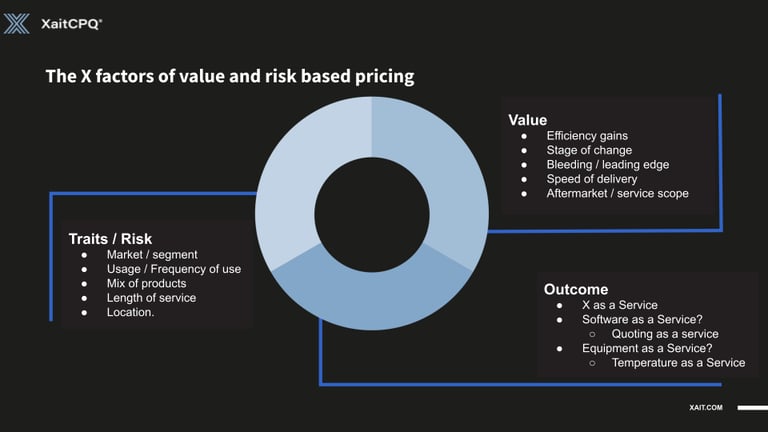
Why the Circular Economy Changes the Way You Go to Market
01.04.2021
-4 min

Software
LET'S TALK!
We offer software that makes you win big and ultimately gives you the work-life balance you deserve.

XaitPorter
Co-authoring and automation solution for complex documents

XaitCPQ
Quickly and accurately price combinations of interdependent products and services
XaitProposal
Guided proposal creation for comprehensive, winning proposals
XaitRFI
The smarter way to respond to RFIs, DDQs and security questionnaires
XaitWebProposal
The easiest way to create interactive and custom mini-websites

XaitAI
The X factor for analyzing and writing winning bids and proposals
Industry
OUR SOLUTIONS BY INDUSTRY
Do you have a question about your business vertical?
Resources
RESOURCES
Discover all our Xaiting resources!
About us
LET'S TALK
We can challenge mindsets and make significant changes to the way people interact

Kevin Geraghty
01.04.2021
-4 min

The earth’s resources are limited, and businesses have a responsibility to use these wisely. For too long, manufacturers have taken resources from the earth to make products that are discarded in landfills at the end of their useful life. This traditional business model – built on the presumption of unlimited and cheap natural resources – is not sustainable.
Both legislation and consumers are applying pressure on companies to switch from their existing open-loop ‘take-make-waste’’ linear business models to a more closed-loop circular ‘reduce-reuse-recycle’ approach; also known as the circular economy.
The circular economy represents a substantially different way of doing business and going to market, replacing established practices like planned obsolescence with new approaches to generating profits.
Read on to learn how shifting your business model away from a linear to a circular economy will bring benefits to your business and understand why a transformation in the way organizations think and operate is required.
The circular economy is an economic system of closed loops in which raw materials, components and products lose their value as little as possible, renewable energy sources are used, and systems thinking is at the core.
Using improved designs for systems, products, materials, and processes, a circular economy aims to eliminate or design out waste, keeping products and materials in use as long as possible.
Our current system is different from a circular economy. We take resources from the ground to make products that we use, and, when we no longer want them, we throw them away. In one year, we harvest approximately 102.3 billion tons of resources.
A new phone comes out, so we ditch the old one. Our washing machine packs up, so we buy another. Each time we do this, we’re eating into a finite supply of resources.
We call this a linear economy, or take-make-waste. We use resources, and they create waste that does not get reused.
In a truly circular economy, the concept of waste does not exist, as everything is reused/recycled.
To shift toward a sustainable society, companies should strive to conserve the use of resources in production as much as possible while deriving the maximum value.
For manufacturing companies, this is particularly important. Traditionally, they have made products, sold them and often replaced items or resold entire systems again. How can businesses go from this linear model to a circular one?
One way of doing it is by looking at waste in their process. However, this is only part of the solution, as it doesn’t fundamentally address the issue (typically for fear of it impacting sales).
To ensure a circular approach, businesses need to shift to an entirely new business model. The first step in this business model transformation is servitization.
In order to apply principles of circularity in its business operations, a company that is used to selling spares and/or replacing components of a machine at regular intervals needs to think about how they can make parts last longer or be refurbished more efficiently.
One potential way to think differently is to consider selling a service. Not the traditional service model, where one fixes a broken machine, but an all-embracing service that ensures the machine performs the ‘outcome’ for which it is intended, consistently and efficiently. This should maximize the value to the recipient and help produce a measurable value to the service.
This is known as servitization i.e. ‘equipment-as-a-service’. An example for heating and air conditioning might therefore be ‘Temperature-as-a-Service’, where the provider agrees to maintain an outcome such as the temperature of a given environment will be between X and Y degrees at all times.
Servitization is a business model where you use your products to sell services. As part of servitization, you take on the responsibility for additional services associated with reuse and recycling materials and components, such as maintenance, to ensure the outcome. It is a practical and necessary step in driving and implementing the key principles of a circular economy.
Transitioning to such a model requires a mind shift, a different way of selling and a new pricing model. In doing so, the balance of risk has shifted from the buyer to the equipment provider.
It is now in the interest of the seller to keep the customer happy through optimum performance – and to make sure the pricing covers the costs to maintain the equipment.
To profitably transition from a traditional “build and sell” business model to servitization, where you engage in a continuous recurring revenue model, you need to be able to calculate the cost, risk and value of tailored multi-year performance-based service agreements.
Balancing risk and value is critical to driving the most value, both internally and externally, from current or future service offerings. Risk and value are two sides of the same coin.
The right technology is required to capture, process and guide decision-making when adopting servitization / Product-as-a-Service strategies. The image below indicates some of the data that can be captuted to inform decisions when judging risk/value.

For businesses facing increasing scarcity of resources, the right business model is becoming crucial for sustained performance and growth. In a circular economy, a new method of business modeling is essential.
Adopting a circular economy approach might enable companies to transition away from take-make-dispose linear production, toward business models that allow goods to be designed and produced for extended use, disassembly, reuse and recycling from the outset.
Your business has a role in driving this shift – and it will require you to embrace change, think differently, act differently, and embrace technology that enables servitization.
With servitization, the balance of risk will shift from buyer to provider. Understanding the expected costs is key, and the risks around that.
Be first to market with a correctly priced service, and competitors will be locked out for years. However, enter into servitization agreements over several years with the wrong cost assumptions, and your business will slowly bleed to death.

Kevin Geraghty
Kevin's passion is helping companies become easier to buy from. He is a pioneer and thought leader in CPQ (Configure, Price, Quote). Quick to spot how technology (in particular CRM and product configuration software) enhances sales team performance, he was instrumental in the development of cloud based CPQ applications. He co-founded BlueprintCPQ in 1999, and built this to become one of the most powerful and flexible CPQ platforms. BlueprintCPQ was acquired by Xait in December 2020 where Kevin is Head of CPQ practice and Managing Director of Xait Ltd where he continues to apply his innovative thinking and experience to drive sales efficiency.

